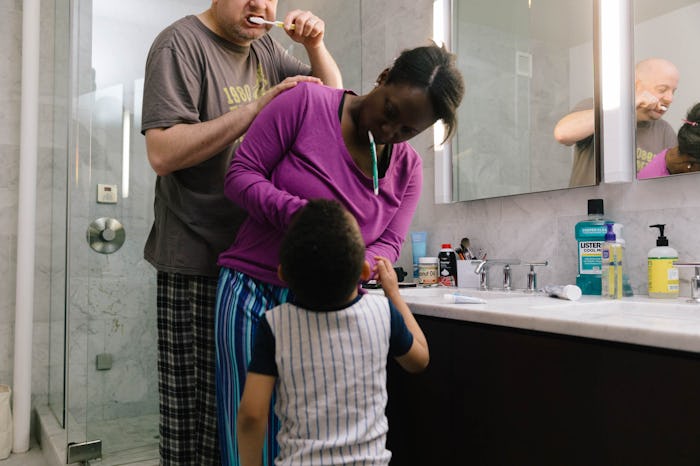Life
If You're Noticing Brown Spots On Your Toddler's Teeth, Here's What It Could Mean
Trying to instill solid dental hygiene practices in a toddler often feels like perpetually climbing uphill with bare feet. Will they ever learn to brush without swallowing so we can move on to fluoridated toothpaste? For that matter, will they ever learn to do this daily task themselves, freeing us up for a precious extra three minutes in the morning? Sometimes, their autonomy seems years away. But, as we all know, early dental hygiene habits are critical and you've probably been doing your job with diligence. So why have you just discovered brown spots on your toddler's teeth?
According to Dr. Mara Teplitsky of Children’s Dental Health, these spots may not be cause for concern. "Discolorations in teeth can sometimes be established during development in the womb," she explains to Romper, but is quick to qualify that more troublesome conditions are also possible. "They can also mean that your child has cavities, especially if they are going to sleep with a bottle or not brushing twice a day. We often warn parents that putting your child to bed with a bottle can put them at risk for dental problems, as the sugars in milk can cause decay as they sit on the teeth overnight."
Dr. Bobbi Stanley of North Carolina agrees that brown spots likely indicate tooth decay. "When teeth aren't being brushed or cared for properly, sugary snacks and beverages can lead to buildup of plaque on the tooth surface that destroys enamel and turns it brown," she explains. "As plaque builds up and hardens, it turns into tartar, which is also brown in color and appears at the line between your toddler's teeth and their gums. Those spots could also come from the dentin underneath the enamel, which appears darker when enamel is damaged or worn down."
Another possibility, according to Stanley, is that the brown spots are a sign of fluorosis, which is caused by excessive fluoride intake. "In most cases, dental fluorosis is very mild and will show as white, lace-looking markings on your child's teeth. Most kids get fluoride from their toothpaste and water, but well meaning parents may try to supplement more — and too much while their teeth are developing can turn teeth brown."
If you think this might be the case in your home, there is both good and bad news. On the plus side, this is only a cosmetic issue and your toddler's affected teeth are still healthy; but unfortunately, the damage is permanent and veneers are usually required to fix it later in life."
If you're starting to get nervous and sweaty just reading this, Stanley can sympathize. "As a mom and a dentist, I know how concerning it can be when you notice something wrong with your children's teeth,'" she says. But don't let your fears keep you from taking immediate action. "If you notice brown spots or brown teeth, it's worth paying the dentist a visit; whether those brown spots are due to decay, tartar, or another condition, your dentist will be able to get to the bottom of it and protect your child's oral health."
Remember that it's never too early for your child to be having regular dentist appointments. Even if you feel slightly ridiculous for taking a 1-year-old to the dentist, the fact remains that if a person has teeth, they should be regularly checked by a medical professional. Just like you, your toddler should be visiting the dentist twice a year so that any problematic issues or bad dental habits can be identified and addressed as soon as possible.
Check out Romper's new video series, Bearing The Motherload, where disagreeing parents from different sides of an issue sit down with a mediator and talk about how to support (and not judge) each other’s parenting perspectives. New episodes air Mondays on Facebook.
